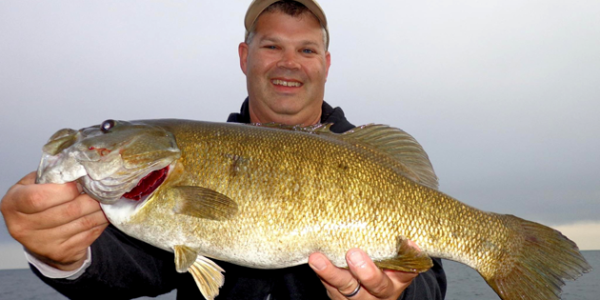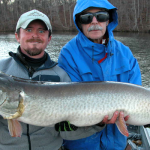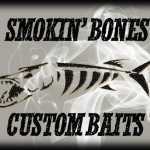By Joseph Alfe
In part one of this series, we explored using bass lures and techniques to catch muskie. Here, we turn the tables and go where few dare to go and that is, to use muskie baits and tactics to catch bass. The thing is, using big baits can get you big bass. How do we know this? Ask any muskie guy what they incidentally catch while chucking big baits, and it will make the average bass guy’s eyes bulge out of their heads, even on pressured waters. Upon reading this, don’t feel the need to run out and stock up on any huge bait you can find, because there is method to the madness.
Time of year
Typically, early spring is a time for smaller, slower presentations, although this wisdom is being challenged in muskie circles. For bass, I would leave the big stuff home in early and even late spring. The exception to this is in reservoir lakes, where big bass tend to suspend in cold water and follow pelagic baitfish out over deep water points and bars. Here, spectacular catches in mid south reservoirs such as Kentucky Lake, Pickwick, and others have been producing huge stringers on the Alabama rig, which to me is a big bait. This has culminated with the new Tennessee state record, a 15.2# behemoth caught on an A-Rig out of Chicamauga Lake this month. The warm summer months and fall tend to be the best big bait times, and when big fish can be aggressive and readily caught on big presentations.
Tactics
Burning blades: For muskies, without a doubt the number one technique is burning bladed baits over weedtops. This means in-line spinners, which you can get moving faster than spinnerbaits. When I say burn, I mean cranking them in with high speed reels as fast as you can. I like Esox Assault EA8’s and 9’s, utilizing double #8 or #9 Colorado blades and iridescent Mag Flash skirts. The things these baits do to big bass at times is a caution, and both largemouth and smallmouth will absolutely pound a set of blades smoked over shallow weed flats or windblown points.
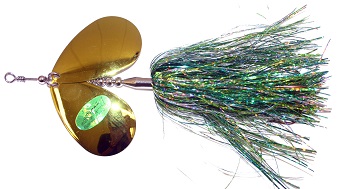
Slow Rolling: Opposite of the burning blades is slow rolling big blades. This can be especially effective late in the year, after cold fronts, or after dark. Here, spinnerbaits excel, and I use a single bladed beast made by Esox Assault in the 1.5-2 Oz range that features a single #10 Colorado blade. This set up produces maximum thump and vibration, just the ticket for rolling down drop offs, around wood and rip rap, and at night. I will also slow roll a big double #10 bladed in-line, the EA10, as well.
Twitchin’: This calls for long minnow type baits of highly buoyant plastic or wood. The best are made of Balsa and have a fluttering action when twitched. I prefer super shallow running baits made by Crane or Custom X. Muskie guys love the “twitch twitch pause WHAM!” routine, and so do big bass. This is another tactic that excels over thick weeds, and a fluttering twitch in a weed pocket will have any big bass in the area pounding the bait. With the squared lips, these baits also work well around docks and timber, and bouncing them off structure will produce big bass when nothing else will. Big crankbaits such as the Smoker SS Shad and the Strike King 10XD are also on the menu.
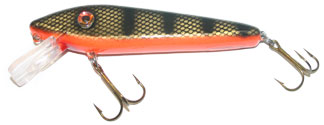
Big Rubber: We all know that soft plastics are made for bass, but we are just now seeing bigger soft plastic offerings. This is another area that muskie guys have had to themselves for a long time, and they can be extremely effective on outsized bass. Out west, guys like Mike Long have pioneered the use of huge swimbaits for bass, but here in the Midwest, guys are scarred to throw them. Don’t be! Articulated swimbaits such as Bucher’s Swimmin’ Joe, River 2 Sea S-Waver, or the Shadillac are just the ticket for big bass. Jerk or glide style baits like the Chaos Tackle’s Medussa come in many sizes, from 1 Oz Mini’s all the way to pound sized. These three-tailed baits can be burned over weeds, bounced down a drop off, or worked through the middle of the water column.
Topwater: Smallmouth especially lose their cool when a big muskie sized topwater gets pulled over their heads. Prop baits like the Bucher Top Raider and River 2 Sea Whopper Plopper will draw spectacular strikes from football sized brown bass. Big walk the dogs also get major action, with big walkers such as River 2 Sea’s Wide Glide and Rover, Rapala’s topwalker, or Mojo’s Weagle getting the nod for action.
Gear
Big baits require big gear. Don’t feel the need to move up to muskie gear though, unless you are throwing really big baits. A good quality, heavy power, fast action flipping stick over 7’ will do the trick. I use an Airrus 7’3” X Entity XHXF, as well as the new Airrus 8’ Wrestle in heavy power. For reels, I am partial to a Curado 300 or Curado 300 EJ, spooled with either 20# Sunline Fluorocarbon or Sunline FX2 braid in 50-65# test.
Big baits for bass is not going to solve all you problems, and it won’t be effective all the time. Moreover, if you are fishing a lake with populations of toothy pike or muskie, you may end up competing with them for the bass’s attention, but make no mistake, in some situations big baits will produce big bass. Sometimes, especially on pressured lakes, giving the fish a look at baits they have never seem before can get you action where others falter, and when throwing big baits, you just might find the bass of your life.
![]()
About Joseph Alfe
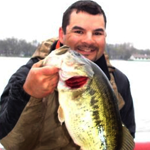
Joseph Alfe, a resident of Northern Illinois, has spent his whole life in pursuit of angling and outdoors knowledge. As a Pro Staffer and brand rep for various industry and outdoors companies, he promotes and shares products that he believes in and that can make you a better fisherman and outdoorsman. For him, it’s all about education. Knowledge is great but you have to be able to get it across in a way that people can understand and be entertained by. Joe’s true passion is bringing relevant and fresh fishing industry news and techniques to his readers through his promotional website, anglerZconnection.com.



